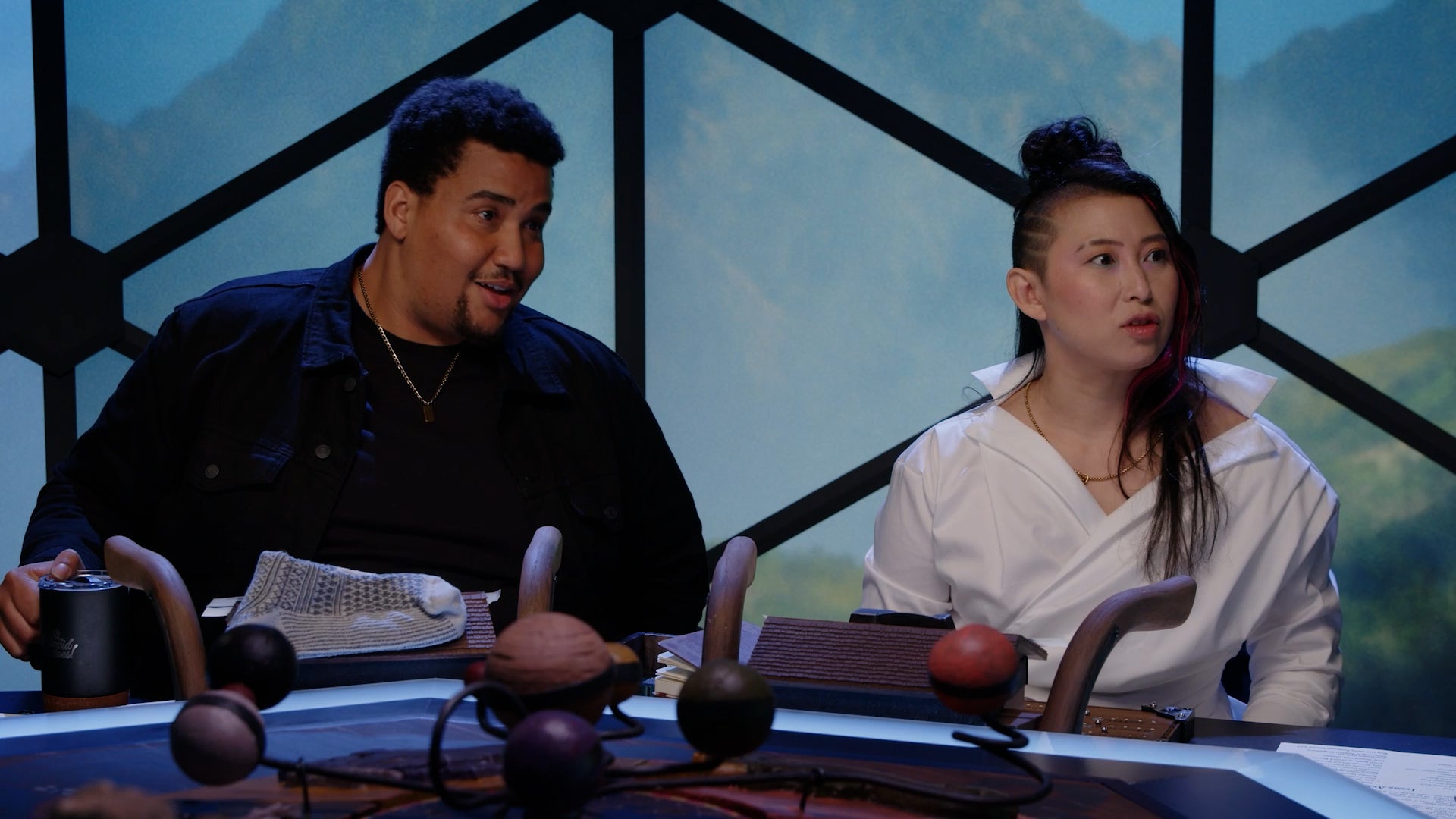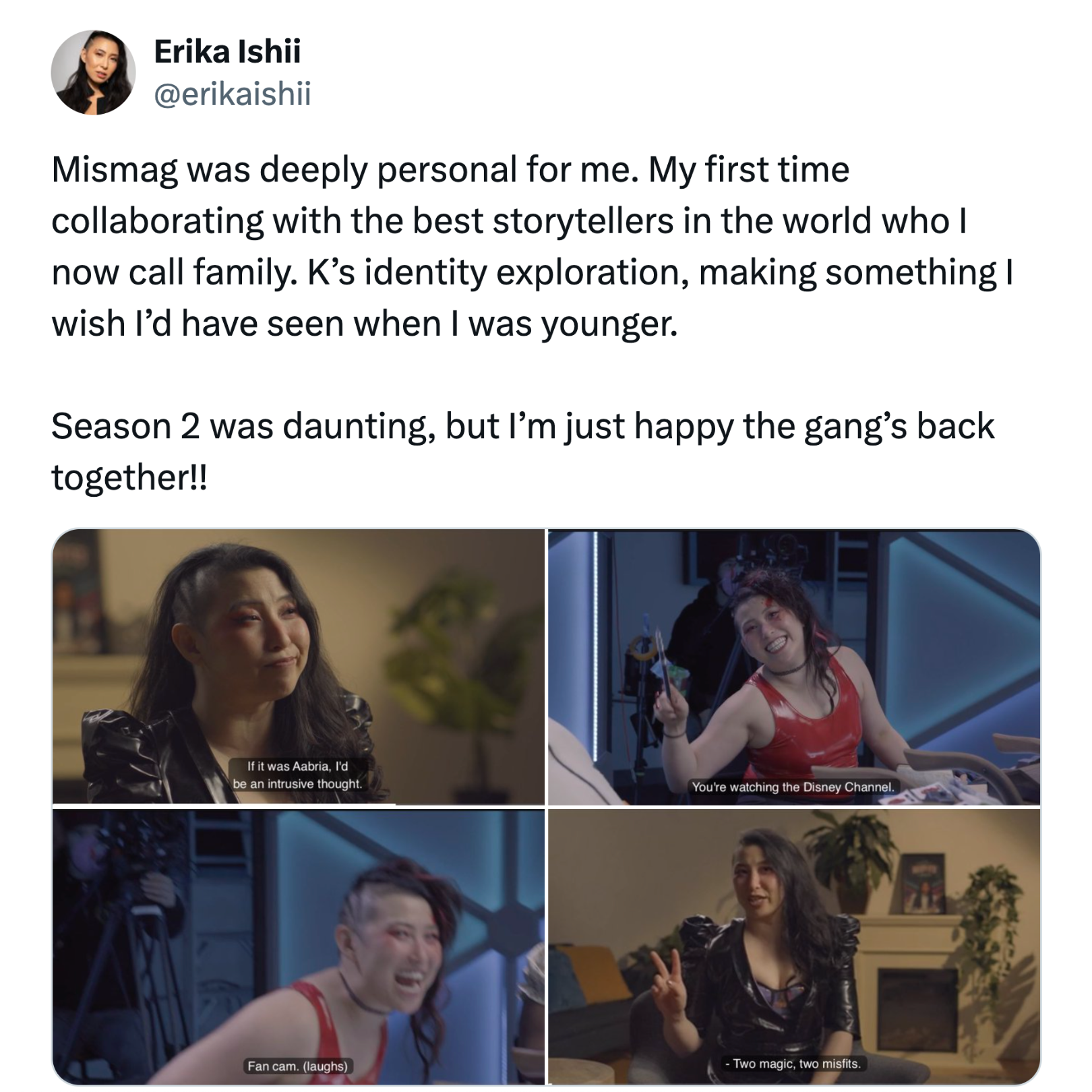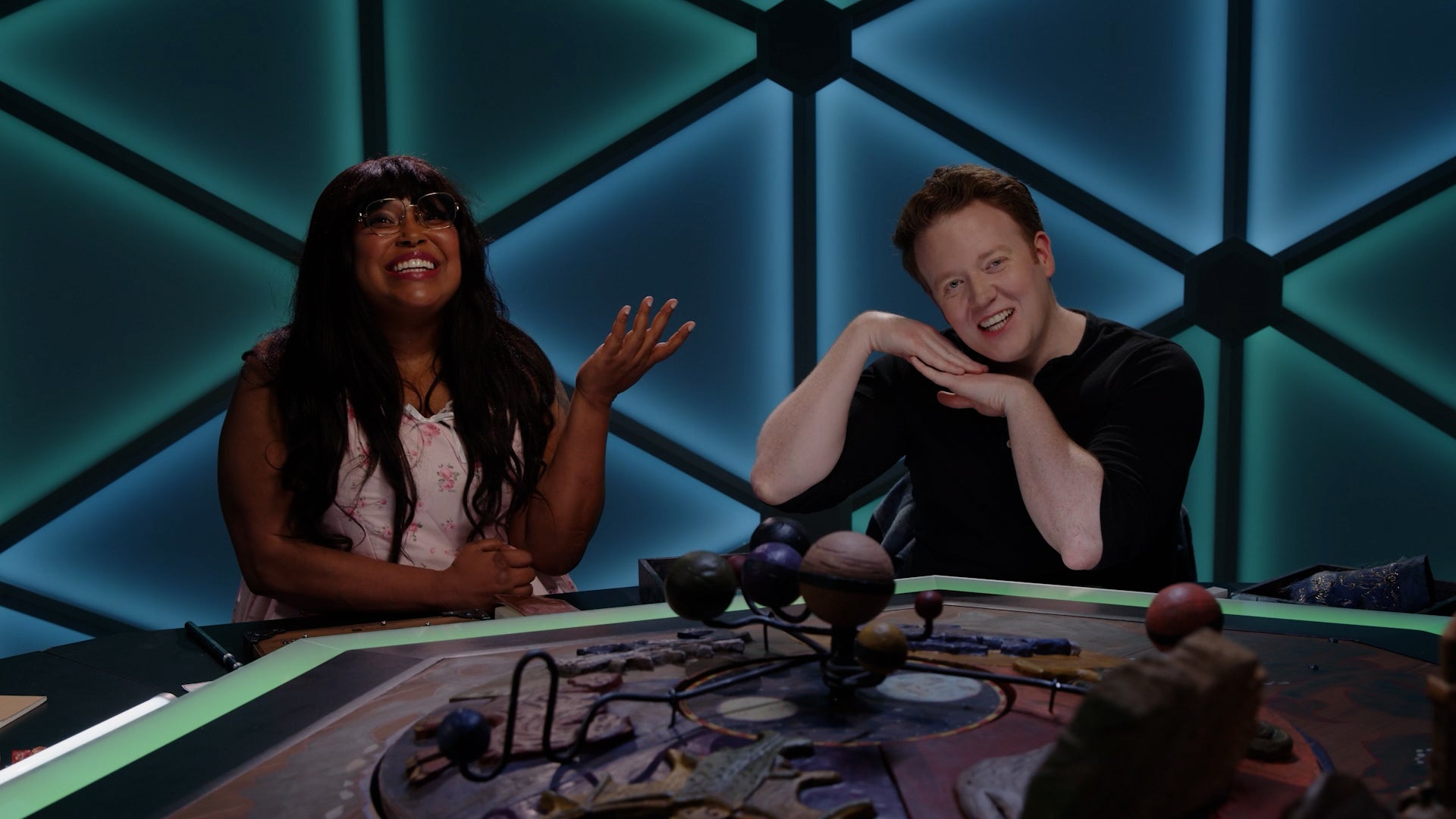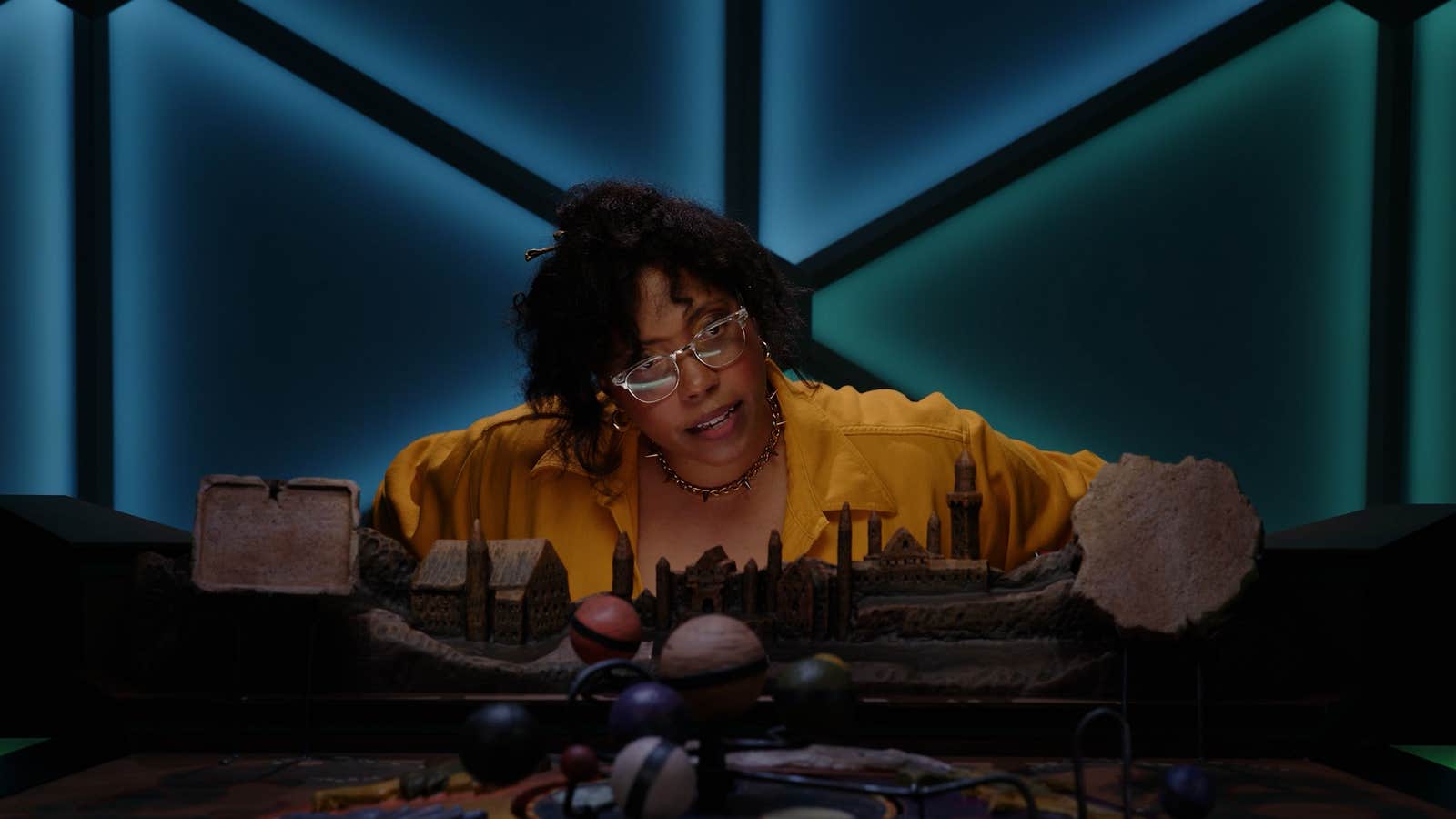We’ve all slept since 2021—everyone except, perhaps, the relentlessly generative creative team of Dropout, an independent streaming service that’s exploded in popularity over the last few years.
Gone are the days when Dropout (formerly CollegeHumor) was underground enough to have its own Discord server. Now, the company gets press releases regularly published in Variety; is Emmy-eligible; and, perhaps most famously, has sold out the Eventim Apollo AND Madison Square Garden thanks to one show in particular. Dimension 20, Dropout’s tabletop roleplaying game (TTRPG) anthology show, has changed the way the public engages with TTRPGs.
Fitting, then, that Dimension 20 celebrates cresting its latest wave of success by returning to an early and beloved project: Misfits and Magic, Dimension 20’s fresh take on the “wizard school” fantasy subgenre. The Daily Dot chatted with some of the MisMag creative team three years ago in time for season 1. Now, it’s time to circle up again with everyone’s favorite magical misfits ahead of their new adventure.
Checking in with the misfits: A party forged anew
In season 1, prolific Game Master Aabria Iyengar welcomed us into the world of Sam Black (Danielle Radford), K (Erika Ishii), Whitney Jammer (Lou Wilson), and Evan Kelmp (Brennan Lee Mulligan)—four ordinary American teenagers recruited to learn magic at the Gowpenny Academy of Arcane Arts, a wizarding school across the pond.
Hijinks ensued as good-ol’-fashioned common sense trumped magical tomfoolery, but three real-world AND in-story years have passed since then. Season 2 finds our misfits at the end of their academic careers, poised to take on the responsibility of possessing true power in the big, wide world. Iyengar was overflowing with enthusiasm about her players exploring this very responsibility—and pressure.
“We are done with them as kids trying to find their way through a school system,” Iyengar told the Daily Dot. “The things that we read culturally here in the West prime us for: ‘All right, you’re about to become a person that can act on the world now. There are repercussions beyond your family unit or your classroom.’ That became a really fun way to explode out the world. … I think it’s as close as I’ve ever gotten to doing something sort of Percy Jackson-related.”

And boy, are these characters feeling the pressure. Teetering on the precipice of true adulthood, season 2 finds them grappling with how to be well-adjusted human beings whilst an entire chaotic world lies before them.
“The magical world is in tatters,” Wilson says in BTS footage of season 2. “But that actually doesn’t matter that much to my character, because my character chose to leave Gowpenny. … Jammer is from the South Side of Chicago, plays basketball, and happened to go to a magical school, and—even as he goes on this next adventure—is trying to hold both these places, hold his friends, but also his community that has shaped and made him.”
Wilson isn’t the only one who’s honed in on themes of community. Ishii, Radford, and Mulligan all voiced similar focuses when telling the Daily Dot about their respective characters.
“Figuring out our identity and how we relate to community is hopefully an ever-ongoing project for all of us,” Ishii said. “But I get the feeling K has often had a difficult time due to defining themself in opposition to things rather than moving towards what they want. Perhaps they can get over themself this season and get more comfortable!”
Radford’s character, Sam, is also thinking through ways to find her path through uncertainty.
“So, so much of this is about how can we come together and together create the world that we want out of the world that we have,” Radford said. “What if you were able to go and get to know this world and be an agent of change in it? How do you still keep your people around you, and what can we do for each other, and how do we take care of each other?”
Mulligan, meanwhile, explores the heartbreaking void created by lack of community. He sees his character as “a reflection of a fear that there is not a place you belong in the world, or a fear that the only places you do belong are places you want nothing to do with.” Evan, above all, wrestles with truly fitting in.
“Our storytelling is about making people feel less alone,” Mulligan said. “That’s what is important about Evan to me: To let people know that feeling is being felt by someone else out there.”
Misfits and magic and marginalization

Iyengar was pleased to see her table instinctively play against the failings of the very western heroic genre they were inhabiting.
“There’s something about heroism, as given, that’s so ruggedly individualistic in hopes that the ends justify whatever buck-wild means,” Iyengar said. “The fact that everyone sort of understood that was the trope they were up against and went like, ‘No. Community. Be aware of how your actions affect the world.’”
“Heroes, especially in Greek-descended ancient myth, have so little internality,” Iyengar continued. “They so rarely grapple with the stakes of their choices. Like, Odysseus wants to come home because he wants to return to the seat of his power. It’s not the struggling with who he is, and who he is becoming. So it’s having everyone really take time to turn the eye inward while on a standard heroic quest and go, ‘Can I seek to do something better if I keep things like community top of mind?’”
Community is absolutely inextricable from identity, as the entire team knows well. In exploring this theme, many members of the team found the campaign resonating with—and even helping them process—their own real-life experiences.
Radford opened up to the Daily Dot about how just as MisMag season 1 acted as a door to the outside world after lockdown, its sequel has been a different kind of gateway.
“Coming out of it, a lot of disabilities from an accident I’d had a few years back had started to really come out and really affect me,” Radford said. “Doing this season was almost a period of being back into the world again. … It’s almost like reintroducing myself to people again.”
Separately, Radford has been experiencing the always-bizarre phenomenon of becoming hypervisible through online renown—and this echoes Sam’s journey from underdog streamer to bona fide celebrity.
“I’m not famous, just kind of recognized,” Radford said. “There is a version of me in people’s head, and that may not relate at all to the version of Danielle that I know or my family knows. And I was able to kind of put some of that into Sam. But people know more about me than I do about them—and like how do I, Danielle the person, process that?”
Furthermore, for Ishii, MisMag has likewise been a space of processing for “a story many of us have had to live over and over.”
“Marginalized people are placed in an unsupportive environment with unrealistic expectations placed on them and expected to fail,” Ishii told the Daily Dot. “I grew up loving fantasy, science fiction, and speculative fiction. There were very rarely people who looked like me, acted or talked like me, shared any cultural or sexual or gender similarities with me. Aabria and MisMag gave me a chance to see myself in a magical world.”
Sam de Leve, who has worked with Dropout for several years and collaborated with the MisMag team as a sensitivity consultant for season 2, told the Daily Dot this campaign has had a personal impact on them “as a trans friend seeing their friend flourish.”
“I’ve been portraying nonbinary/trans characters on camera since 2017 when I started as an Actual Play performer at Geek & Sundry, and that’s where I met Erika Ishii while we both worked at that studio for a couple years,” de Leve said. “I can’t tell you how much joy it gives me to see Erika grow in their own gender and to see that journey reflected in a character on MisMag.”
All these disparate and interlocking streams of identity and self-actualization are aided even further by MisMag departing wholly from its referential season 1 origins. Season 2 leaves all echoes of a certain mainstream wizarding world (a painful fragment of a much vaster literary canon) thoroughly behind.
“I think there also was not just moving away from something, but moving towards a story that is new and meaningful and thematically rich—and, you know, as always, f*ck TERFs,” Mulligan said. “There is very little in this season that I would describe as parody, and there is instead much more that I think is novel and rich and textured and of a world-building that I think is going to feel very welcoming to all the people that we want to make most welcome with this season of the show.”
Never stop making magic: Making the most of a sequel

Iyengar and the team around her have always known they would return to the world of Misfits and Magic. The question was not “if,” but “when.” In interviews with the Daily Dot, Iyengar and Mulligan both noted that it was all about going away for some time before coming back at the right time, with the right story.
“We were halfway through taping the first episode when Sam Reich was outside the dome being like, ‘Season 2?’ Mulligan said. “It was ultimately Aabria’s call, but one of the things I advised Aabria was like—’We should do this again one day, and you should go to other worlds first before you come back to this one.’ … It’s the same thing with the junior year for Fantasy High, where it was like, I only wanted to go back when I thought I had the story that felt interesting to me.”
Now, three years later, Iyengar feels certain it’s the right time for a sequel and she has the right story to tell. She also feels fully comfortable in her world-building and mechanics-crafting skills as a Game Master—an ease she’s more than earned after three high-octane years of back-to-back GMing for and playing in prominent TTRPG campaigns.
“The world is wide and magical and dangerous—and you only have each other in a very specific goal—felt like a new fun thing to dig into and play in the themes that we established in MisMag 1, but elevate it and do something new for the new season,” she said. Simply put, and, in her own words, she’s “got cool sh*t in the pocket.”
Her table is still glowing from the fires of a vaster, darker, and infinitely more high-stakes MisMag. Multiple players alluded to a certain jaw-dropping explosiveness that Iyengar brought in to make her sequel sing.
“Aabria continues to pioneer and escalate an arms race in new props, game systems, and world-building,” Ishii said. “I’m just happy to be along for the ride.”
Wilson specifically praised the intensity of Iyengar’s updated mechanics in his BTS clip, saying the new system is “exciting, and feels reflective of a world in which there are moments where nothing happens, and there are moments where great and powerful things happen when you least expect it.”
Ultimately, the creatives of Misfits and Magic season 2 want audiences to know they’re in for a truly one-of-a-kind journey.
“I don’t think anyone could anticipate this story from season 1,” Mulligan said. “This is not [a clone of the first season]. This is a wild and dark and cool and fantastical direction for these characters and the world and the story to move in. And I think Aabria knocks it out of the f*cking park.”
“I don’t know how to explain to you the things that Aabria has thrown at us this season,” Wilson said. “All I can say is ‘buckle in.’”
Weekly episodes of Misfits and Magic‘s 11-episode second season will available to watch on Dropout, starting on Sept. 25.
Internet culture is chaotic—but we’ll break it down for you in one daily email. Sign up for the Daily Dot’s web_crawlr newsletter here. You’ll get the best (and worst) of the internet straight into your inbox.


